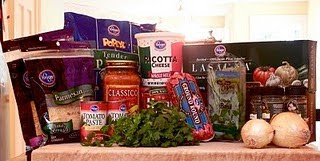Lest you think I don't do savory...
Lasagna’s easy - at least I think. Until this evening, I’d never made it. But I’ve watched my mom make it my entire life. It doesn’t matter what order the layers go in or if you forget a layer of sauce or cheese. You just make up for it later. I’ve always thought you just couldn’t mess it up. And now I’m convinced that my assumption is absolutely true.
Lasagna’s also likable. You like spaghetti? You like lasagna. You like chicken parmesan? You like lasagna. You like pizza? You like lasagna. The funny thing is though – I always forget that I like lasagna until I’m eating it.
I found this recipe at mylasagnarecipe.com (of all places). Then I destroyed it. I changed the spices. I added spinach. I added more meat. I exchanged half the noodles for whole grain. I used vodka sauce instead of Bolognese. The recipe in this post is the one I used – not the original.
A note on cooking: Keep it in the oven until it bubbles. I’m sure an hour is sufficient, but I kept it in for longer to give it more of a cheesy crust. The crunch is the best part. NOM NOM NOM.
This crunch.
Ingredients
1 pound of bratwurst (or any package of Italian sausage)
1 pound of ground beef
Cooked ham (thick slices, not steaks) to your liking
1/2 cup of chopped onions
2 cloves of garlic chopped
1 (28 ounce) can of crushed tomatoes
1 jar of vodka sauce
2 (6 ounce) cans of tomato paste
1/2 Cup of water
2 tablespoons white sugar
1 teaspoon fennel seed
2 teaspoons fresh Basil leaves (rough chopped
)
4 tablespoons fresh Italian parsley (rough chopped)
1 teaspoon salt
1 teaspoon oregano
1/2 teaspoon ground pepper
23 ounces of ricotta cheese (a normal, large container is 30 oz, so almost all)
1/2 teaspoon nutmeg
1 egg
1 pound shredded chedder and mozzarella cheese
1 pound grated Parmesan cheese
Fresh spinach leaves
14 lasagna noodles (whole wheat & regular) (2 boxes is more than enough for lots of noodle overlay – 1 will do, however)
To make lasagna
Preheat oven to 350 degrees F. Start your lasagna by halving each sausage and then cutting each half into about 8-10 pieces. Bite-size pieces are important. Combine the sausage with the ground beef, onions, and garlic cloves in a medium size pot or Dutch oven.
Brown the ground beef, Italian sausage, onions and garlic in a pot until they start to cook. This should take about 6-9 minutes on medium-low temperature. If you prefer, once the meat is browned, drain the grease. (I did not, but I used high-grade, lean beef.)
Add the crushed tomatoes, the tomato sauce, the tomato paste, and the water, gently stirring them into the mixture. Mix the sugar, fennel, fresh Basil, fresh Italian parsley, salt, oregano, and pepper into the sauce. Cover the pot and let the meat sauce simmer on low for 1 - 1 ½ hours.
While the pot is simmering, soak the lasagna noodles in warm water. The noodles need to be soaked in warm tap water for 15 minutes.
While the noodles are soaking, combine the ricotta, nutmeg, egg, and another 2 tablespoons of chopped, fresh Italian parsley. Mix these up with a spoon.
Once the sauce has simmered for at least an hour, start to build your lasagna. Using a 9×13 inch baking pan, spread 3 Cups of meat sauce on the bottom of the pan. Lay 5-6 noodles across the layer of sauce, making sure to shake off excess water first. Spread a layer of the ricotta cheese mixture over the layer of noodles until they are clearly covered. Spread 1/2 of the cheese (mozzarella and cheddar) over the ricotta layer.
Sprinkle some of the Parmesan cheese over the mozzarella layer. Add in a layer of ham of spinach. Repeat these layers until you’ve reached about a centimeter from the top of the baking dish. Make sure plenty of cheese is your top layer – preferably lots of parmesan.
Bake at 350 degrees F for 25 minutes. Cover with foil and bake for another 25 minutes. Remove foil and bake until cheese is browned to your liking. Allow lasagna to cool for at least 15 minutes. Works well frozen and reheated too!






































